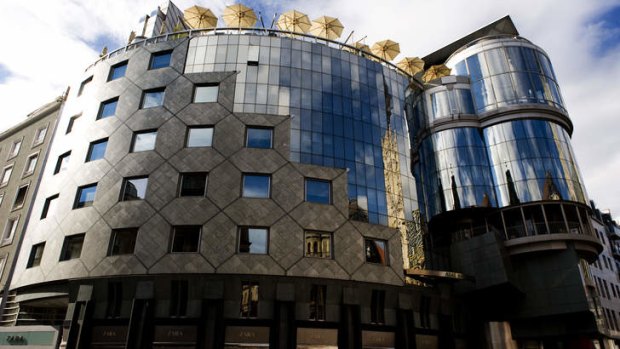
Modern Haas House was one of the most disputed building projects of the late 20th century in Vienna.Credit: Getty Images
In a city of grand designs, Helen O'Neill traces the footsteps of the architect who led her there.
With certainty of purpose and mischievous grins, two young brothers push open the heavy door of central Vienna's Jesuit Church and, followed by their father, step inside. You would never know it from Doktor-Ignaz-Seipel-Platz, the street outside, but this seemingly modest 17th-century building contains an astounding interior - a rich, baroque kaleidoscope of twisted marble columns, gold detailing, lavishly carved wood and intricate artwork, high above which floats a magnificent, soaring dome.
The boys ignore it, oblivious, their busy eyes darting across the floor. They find what they're looking for and head towards it. My thoughts turn to the Viennese-born man who guided me here, the late architect Harry Seidler and I wonder whether, as a youngster, this is something he did too.
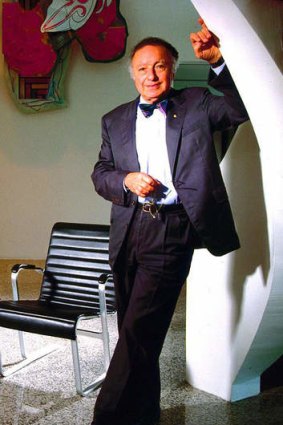
The late architect Harry Seidler.
Seidler lived in this city until the age of 15 when Adolf Hitler's 1938 annexation of Austria forced his family, who were among those fortunate enough to survive the Holocaust, to flee.
As an adult he returned repeatedly, in 2003 (three years before his death) publishing The Grand Tour: Travelling the World With an Architect's Eye, a photographic book documenting the globe's peak architectural achievements, within which lies a series of Vienna highlights. This church is the first on that list.
The two brothers find their quarry - a pale stone on this church's red floor - and taking turns they stand on it and gaze up. Why? Because they know that this church holds a secret and the lonely white stone is its key.
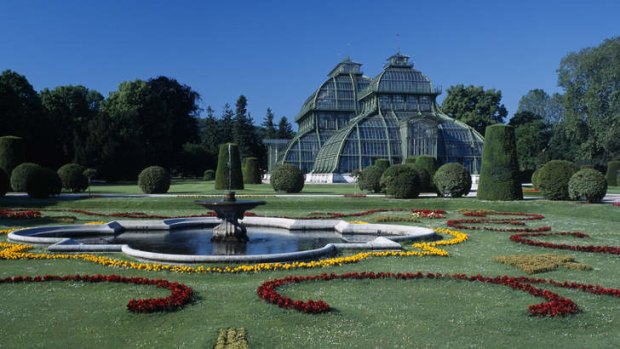
Schonbrunn Palace.Credit: Getty Images
It marks the perfect place to view what is an extraordinary optical illusion. In truth, this church's spectacular ceiling is far flatter and less elevated than it appears. The eye is tricked into seeing a high dome by a trompe l'oeil fresco created in the early 1700s by architect Andrea Pozzo.
As 300-year-old jokes go, it is beyond compare and proof - as if that's needed - that in a metropolis as architecturally rich as Vienna, nothing cuts through the cliches better than recommendations from one of its most design-conscious sons.
There are various ways of exploring Vienna by using Seidler as a guide. His Grand Tour "must-sees" embrace major monuments of many architectural styles, from Gothic and Baroque to Modern.
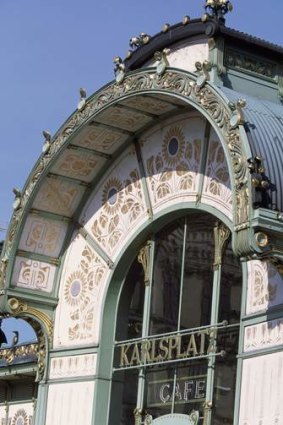
Karlsplatz station.Credit: Getty Images
Recommendations include Fischer von Erlach's ornate 18th-century Spanish Riding School (home to Vienna's pirouetting Lipizzaner stallions); the grandiose Belvedere Palace (completed in 1821, created by Lucas von Hildebrandt); the palm house at Schonbrunn Palace (1880-1882, Franz von Segenschmid); the Gothic, 14th-century St Stephan's Cathedral in the city's pedestrianised heart and, a mere schnitzel's throw away, Haas House by Hans Hollein (1987-90) - the once-controversial, uber-modern hotel/restaurant/office complex featuring quasi-mediaeval curves and a fascinating, reflective facade.
But at first glance, like a Eurovision Song Contest final, Seidler's list also holds a few surprises.
Take the 1906 Nussdorf flood control building (of interest because its creator is the influential art nouveau architect Otto Wagner, whose landmark structures lie across Vienna), and the flamboyantly marble-framed, gilded monument to Vienna's waltz wizard Johann Strauss (by Edmund Hellmer, 1921, particularly beautiful when lit up at night) situated on the Stadtpark, which borders the Ringstrasse.
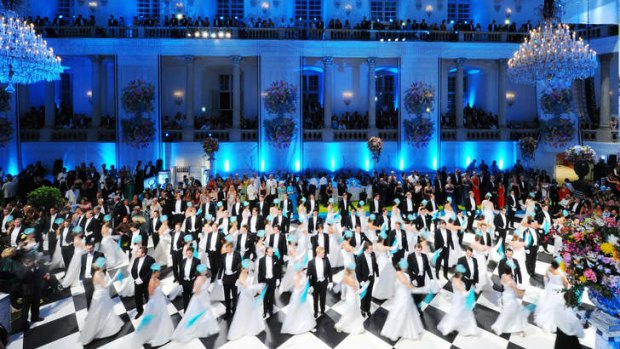
Vienna Hofburg.Credit: Getty Images
Then there's an elegant, intimate boutique - originally a candle shop - created by Hans Hollein (1964-66) in the prestigious Kohlmarkt, central Vienna's luxury shopping destination. A visit quickly explains Seidler's fascination. This shopfront, with its keyhole-shaped entrance, seems to be a piece of art in its own right, appearing effortlessly sculpted from invisibly fused sheets of aluminium.
A few doors down in this bustling, touristy street Seidler's Vienna takes on a more personal edge. Demel's, the celebrated cafe/patisserie, where visitors can watch the staff chocolate and confectionary art through a glass partition is worth a visit on any occasion, and also happens to have been a favoured Seidler haunt where, his widow Penelope Seidler recalls, he had a particular penchant for mohn (poppy seed) strudel.
As with any itinerary, venturing beyond the city centre pays dividends. Exiting the U4 train line at its 19th district's Heiligenstadt station and you come face-to-face with the Karl-Marx-Hof complex (Karl Ehn, 1926), an imposing, seemingly Cubism-inspired red and cream creation admired by the adult Seidler as a pioneering piece of public housing and engraved on his childhood memory.
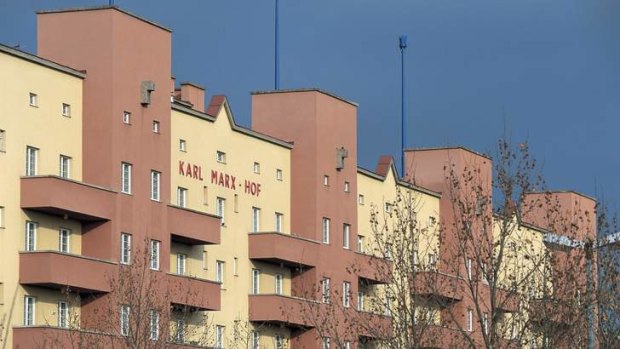
Imposing facade of Karl-Marx-Hof complex.Credit: Getty Images
In February 1934, as a wall plaque commemorates, this became the site of a bloodbath when the fascist government's armed forces fired on workers barricaded inside. The Seidler family lived relatively near and young Harry, off school with scarlet fever, said he could hear the machinegun-fire from his bed.
Another key Seidler stomping ground is closer to the city centre at Vienna's 9th district, where he was born, lived (before moving to the 19th), and attended secondary school at the Wasagymnasium (Wasagasse 10), a short walk from the U2 Schottentor station. During my daytime visit this sleek neighbourhood (which is also handy for the Sigmund Freud Museum at Berggasse 19, the analyst's home/office (freud-museum.at) seemed peppered with yummy mummies sporting soft leather trousers, expensive shoes, expertly coiffed hair and, despite the narrow streets, top of the range Jeeps.
The past intersects with the present much more poignantly at the austere, concrete and steel Holocaust Memorial at Judenplatz, another Seidler recommendation. Set in a pedestrianised square in the stately 1st district and created to evoke the image of unreadable books, this tribute to the 65,000 Austrian Jews murdered in the Holocaust (2000, by artist Rachel Whitehead) is a sobering, meaning-soaked monument to the past.
Many of those who survived opted never to return. Seidler not only came back but built here, creating one of the most personally significant, and sizeable, commissions his architectural practice undertook.
Reaching it involves taking the U1 north-east to Donau Insel and walking into Wohnpark Neue Donau - a complex commissioned by the city and completed in 1998, which includes subsidised social housing apartments, a type of residence the architect held dear.
In Australia, particularly in Sydney, this architect's work is part of the landscape; there is something surreal about wandering through an entire 850-apartment Seidler neighbourhood located so far from his adopted home. His signature curving white walls are here; as are wave-like, water-view balconies (these apartments being orientated to maximise the vista across the Danube) with everything bound together in a characteristic interplay of texture, line, light and shade.
As ever there is artwork, in the form of huge murals by Lin Utzon (daughter of Sydney Opera House architect and Seidler's friend Jorn Utzon) adorning the higher apartment blocks' outside walls.
The place is not pristine. Some of the landscaping appeared in need of a little attention, and the curving, pale cinema created as part of the larger complex looked spooky and emphatically closed.
Back in Vienna's Museum Quarter, the Architecture Centre (Museumsplatz 1, 1070 Vienna, azw.at) was hosting an exhibition of Austrian Architecture from the last 150 years. Many significant architects were featured yet Harry Seidler was not mentioned at all. I asked two staff members if they recognised his name. "Of course," came the nodded reply. Any idea why he does not appear here? They had none at all.
Curator Monika Platzer cited space restrictions, pointing out this exhibition hall is relatively small.
For many Vienna is all about music, balls and grand opera but although the metropolis is full of extraordinary buildings, the architecture itself runs the risk of being overlooked.
"Harry Seidler didn't build a lot in Austria," she added, questioning whether his Viennese work represents his best and speculating that one day, perhaps, he may be included.
"They should have brought him back ... earlier."
Helen O'Neill is the author of Harry Seidler: A Singular Vision (HarperCollins, $49.99). She travelled courtesy of Austrian Tourism.
TRIP NOTES
GETTING THERE
Emirates, which partners with Qantas on flights to European cities, flies daily from Sydney and Melbourne to Dubai with daily connections to Vienna. Phone 1300 303 777; see emirates.com.
STAYING THERE
For design-lovers, the sculptural, modern Vienna Stephansdom Sofitel, designed by Jean Nouvel to echo St Stephan's Cathedral. Rooms from $405, Praterstrasse 1, see sofitel.com.
Those preferring the individual touch should check out the quirky Altstadt Vienna, where every room is a different design, Kirchengasse 41. Rooms from $166. See altstadt.at
MORE INFORMATION
Sign up for the Traveller Deals newsletter
Get exclusive travel deals delivered straight to your inbox. Sign up now.